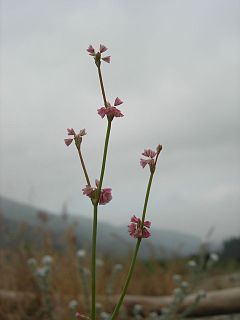
Eriogonum davidsonii is a species of wild buckwheat known by the common name Davidson's buckwheat. This plant is native to the southwestern United States and northern Baja California, where it grows in sandy or gravelly soils in a variety of habitats. It is a spindly annual herb growing up to 40 centimeters in height. The fuzzy leaves are located at the base of the plant and are one or two centimeters wide and round with wavy or wrinkly margins. It is variable in appearance, but is generally erect with thin, naked, neatly branching stems bearing clusters of tiny flowers at widely spaced nodes. Each flower is about 2 millimeters wide, bell-shaped, and usually pink.

Eriogonum deflexum is a species of wild buckwheat known by the common names flatcrown buckwheat, flat-top buckwheat, and skeletonweed. This plant is native to the southwestern United States and northwestern Mexico, where it is common and grows in a variety of habitats, especially desert scrub. It is somewhat weedy where it is most abundant. This is an annual which varies in size from small patches on the ground to tangled bushes approaching two meters in height; it may be dense or thin and spindly. This is a brown or greenish weedy-looking herb with a many-branched stem. The leaves are located at the base of the plant and are rounded and woolly and one to four centimeters long. Small clusters of flowers appear at intervals along the branches with each flower only one to three millimeters wide and white or pinkish in color.

Eriogonum elatum is a species of wild buckwheat known by the common name tall woolly buckwheat. It is native to the western United States from California to Idaho. It is a perennial herb varying in size from one half to 1.5 meters in height. Its long leaves are located at the base of the plant and can be quite long for a buckwheat, over 20 centimeters in maximum length. The erect, branching stems are thin and naked and occasionally hollow. The plant produces small to large inflorescences with clusters of tiny flowers in shades of white to dark pink.
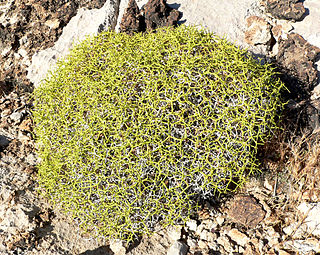
Eriogonum heermannii is a species of wild buckwheat known by the common name Heermann's buckwheat. It is native to the southwestern United States from California to Utah where it grows on rocky slopes, desert flats, and dry washes.
Eriogonum intrafractum is a species of wild buckwheat known by the common names jointed buckwheat and napkinring. This plant is endemic to Inyo County, California, where it is known only from the mountain ranges surrounding Death Valley. It is an uncommon, distinctive perennial herb which grows in scattered patches on rocky limestone soils in these desert mountains.
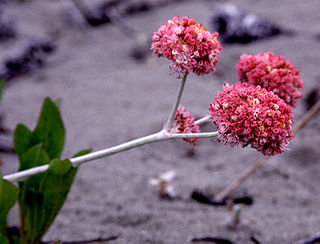
Eriogonum latifolium is a species of wild buckwheat known by the common names seaside buckwheat and coast buckwheat. This plant is native to the coastline of the western United States from Washington to central California, where it is a common resident of coastal bluffs and scrub.

Eriogonum nidularium is a species of wild buckwheat known by the common name birdnest buckwheat. It is native to the sandy flats and desert dry washes of the Mojave Desert and Great Basin in the western United States, where it is common and abundant. This is a distinctive annual herb producing a thin, multibranched stem which curves in on itself to form a rounded, tangled mass.

Eriogonum nummulare is a species of wild buckwheat known by the common names Kearney's buckwheat and money buckwheat. It is native to the Great Basin of the United States from California to Utah, where it grows on sandy slopes and plateaus.
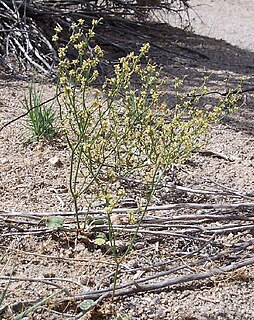
Eriogonum ampullaceum is a species of wild buckwheat known by the common name Mono buckwheat.
Eriogonum apiculatum is a species of wild buckwheat known by the common name San Jacinto buckwheat. It is endemic to California, where it is known from the San Jacinto, Santa Rosa, Palomar, and Cuyamaca Mountains of San Diego and western Riverside Counties. Its habitat includes chaparral and wooded slopes on granite sands. This is an annual herb producing a spreading to erect, glandular stem up to 90 centimeters tall. The oblong leaves appear at the base of the plant. They are hairy and glandular in texture. Most of the stem is made up of the inflorescence, branching, spindly cyme with clusters of flowers at the tips of the branches. The individual flowers are under 3 millimeters wide and are white in color with reddish stripes.

Eriogonum cernuum is a species of wild buckwheat known by the common name nodding buckwheat. It is native to much of western North America, where it grows in sandy and gravelly habitat, including woodland and sagebrush. It is an annual herb growing up to about 60 centimeters in maximum height with a thin, branching flowering stem. The rounded, woolly leaves are one or two centimeters wide and are mainly located about the base of the stem. The inflorescence is evenly lined with hanging involucres of flowers. The individual flowers are less than 2 millimeters wide and white to pink-tinged in color.

Eriogonum eremicola is a rare species of wild buckwheat known by the common names Telescope Peak buckwheat and Wild Rose Canyon buckwheat. It is endemic to Inyo County, California, where it is known from only a few occurrences in the Inyo Mountains and Telescope Peak in Death Valley. It grows in sandy to rocky habitat in the forests and woodlands of these desert mountains. It is an annual herb producing a spreading, glandular, reddish green stem up to about 25 centimeters tall. The rounded, woolly leaves are up to about 2.5 centimeters long and are located at the base of the stem. The scattered inflorescences are small clusters of tiny flowers which are white with reddish stripes, aging to solid red, or sometimes yellow. The plant is under protection in Death Valley National Park.
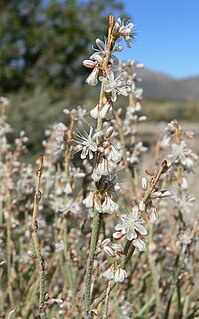
Eriogonum panamintense is a species of wild buckwheat known by the common name Panamint Mountain buckwheat. It is native to several of the desert mountain ranges of eastern California and western Nevada, including the Panamint Range. It grows in various types of mountain ridge habitat, such as sagebrush and coniferous woodland.
Eriogonum pendulum is a rare species of wild buckwheat known by the common name Waldo buckwheat. It is endemic to the Klamath Mountains of Josephine County, Oregon, and Del Norte County, California, where it is a member of the serpentine soils flora.

Eriogonum spergulinum is a species of wild buckwheat known by the common name spurry buckwheat.
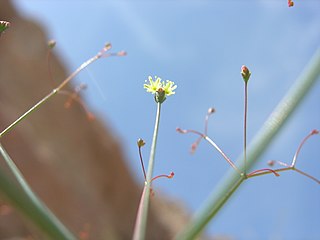
Eriogonum thomasii is a species of wild buckwheat known by the common name Thomas' buckwheat. It is native to the desert southwest of the United States and northern Mexico where it is common in many areas, sometimes becoming a weed.

Eriogonum thomasii is a species of wild buckwheat known by the common name Thurber's buckwheat. It is native to the desert southwest of North America in Arizona, California, New Mexico and three desert states of Mexico, where it is common to abundant in many areas.
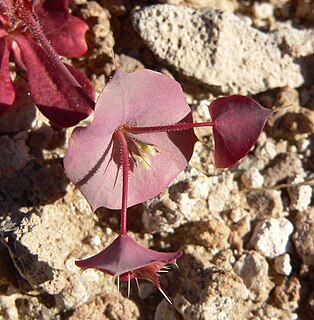
Oxytheca perfoliata is a species of flowering plant in the buckwheat family known by the common names round-leaf puncturebract and roundleaf oxytheca. It is native to the southwestern United States, where it is a common plant of the deserts and some woodland and valley areas. It is an annual herb producing a leafless stem up to about 20 centimeters in maximum height in the spring; during the winter the plant is a small rosette of oblong or spoon-shaped leaves a few centimeters wide. The plant is red-veined green, or often brown to maroon or magenta in color. The inflorescence atop the stem is punctuated by nodes at which the bracts are fused to form a cup or band up to about 2.5 centimeters wide. At the end of each branching of the stem is a similar cup of bracts partially fused around a cluster of flowers. The bracts are tipped in spinelike awns. The flowers are white to yellow-green and hairy in texture.
Eriogonum evanidum is a rare species of wild buckwheat known by the common name vanishing wild buckwheat. It is native to southern California and Baja California, where it has been collected from widely scattered areas. Most historical occurrences are now extirpated and the plant has not been collected since 1967. Some sources suggest that it is probably extinct. The plant was described as a new species in 2004 using specimens that were set aside from a collection of Eriogonum foliosum on the basis of some morphological characteristics. The specimens came from several locations in the southern California mountains, including Bear Valley in the San Bernardino Mountains and Pine Valley east of San Diego.

Eriogonum niveum is a species of flowering plant in the buckwheat family known by the common name snow buckwheat. It is native to the Pacific Northwest of North America, where it occurs in British Columbia, Washington, Oregon, and Idaho.
















